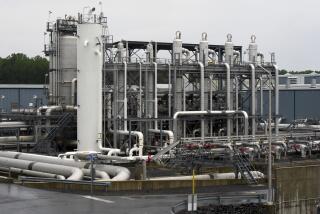Firms Eye Baja for Liquid Gas Terminals
- Share via
MEXICO CITY — An international assortment of energy companies is combing Baja California for places to build enormous--and enormously risky--liquid natural gas terminals, a kind of project never before seen on North America’s Pacific Coast.
Baja already is witnessing a spurt of power plant construction by companies looking to supply electricity to energy-starved California. The power plant builders chose Baja partly to avoid California’s costly and time-consuming permitting process.
Promoters of liquid natural gas, or LNG, terminals--which carry price tags of $300 million or more--are eyeing Baja for the same reason: to get the plants on line as fast as possible and sidestep the almost-certain resistance by California environmentalists to such projects.
If built, the facilities would supply fuel via pipeline to power plants and consumers on both sides of the border, but mainly California. The Baja terminals would receive liquefied, compressed and supercooled gas transported by ship from as far away as Indonesia, Australia and Chile. Unlike North America, gas supply in those regions vastly outweighs demand.
Sempra Energy Chairman Stephen L. Baum said Friday that the San Diego-based company will soon announce plans for a $350-million project to be situated between the U.S.-Mexico border and Ensenada, which lies 70 miles south. Sempra said it is considering building a floating terminal as well as a land-based design.
Although the Mexican government has yet to grant a permit for any LNG facility, Mexican energy secretary Ernesto Martens said in a talk last month in La Jolla that he envisions one or two LNG plants being built in Baja in coming years.
Sempra, El Paso Energy, Royal Dutch/Shell Group, British Gas, Chevron Corp., Repsol of Spain and TotalFinaElf of France are interested in building or partnering plants in Baja, top Mexican and industry officials said.
The idea behind supplying gas to California and other Western states has been driven by the state’s energy crisis, triggered partly by the scarcity of gas, the fuel used to power many of the generators.
Some analysts were dubious about the projects, saying that the high cost and four- to five-year construction time might make them unnecessary and unprofitable by the time they are on line. Also, any new plant could be competing against pipeline projects that have been proposed to bring more gas to California from the Midwest, Canada or Alaska.
“It’s a foot race to some extent,” said Sondra Scott, Latin America specialist at Cambridge Energy Research Associates in Mexico City, adding that any LNG project faces a host of market and permitting issues, even in Mexico. “It’s naive to speculate on whether these projects will go ahead,” Scott said.
The plants represent a bet that natural gas prices will remain at least at $3.50 to $4 per million British thermal units over the long term. That’s the minimum price at which companies can make a profit bringing LNG to market and at which the plants would pay for themselves.
After averaging $2 to $2.50 for most of a decade, gas prices spiked as high as $10 over the last several months as short supplies combined with a boost in consumption to cause a market squeeze. Prices have since settled to below $4 per million BTUs.
“This is a risky business if there ever was one. You need deep pockets, a bit of faith and a firm will,” said Mexico City-based energy analyst David Shields, who is skeptical that LNG plants will be built.
Baum said his company is convinced that the long-term outlook for gas prices is high enough that his project will make financial sense. The company is in talks with a number of natural gas producers in Asia and Latin America that are stuck with “stranded” energy--meaning gas they can produce but can’t find customers to buy.
“We are in advanced discussions with market participants and we have identified both land-based and floating project locations,” Baum said. “In about a month, we’ll announce our team.”
Baum said that engineering issues surrounding the construction of a floating LNG terminal have been worked out and that the company will have no problem financing its cost even though, according to Baum, it would be the first such floating terminal built in the Western Hemisphere.
But Scott of Cambridge Energy warned that any LNG plant coming on line after 2004 runs the risk of being too late. Her firm predicts that California’s energy crisis will be over by then because of the additional gas pipeline capacity that will be feeding the state.
Shell declined to comment on reports that it was interested in building a Baja plant. A spokesman noted that the company is recommissioning a mothballed LNG plant in Cove Point, Md., that was shut down years ago because low gas prices made it unprofitable. In reopening the facility, Shell is sending a message that it believes that gas prices will remain at current levels or higher in coming years.
Shell “has said in the past that we see LNG as a growth opportunity,” said spokesman Michael McGarry, who described Shell as the world’s largest LNG producer.
El Paso Energy said in February that it will build a new LNG plant at an unspecified site in Baja California but has not yet released details. The company later said that such a facility would import LNG produced by Phillips Petroleum Co. in Australia.
El Paso Energy said it will build an LNG facility in the port city of Altamira on the Gulf Coast of Mexico. The project could supply the United States via pipeline and Mexico, which is facing a natural gas crunch of its own.
Repsol, British Gas and Petroleo Brasileiro, or Petrobras, other stakeholders in the giant gas fields in Bolivia, Peru and Argentina, were sizing up the idea of building an LNG processing plant in northern Chile, where their gas would be liquefied and then transported by ship to Baja, analysts said.
Repsol, which has vast natural gas deposits in Argentina and Bolivia, also is scouting sites in Baja, a Mexican official said. Chevron, which has said it is considering a possible LNG project somewhere “on the Pacific Coast of North America,” is due in Baja this week to tour possible locations, the official said.
In the event there is competition among the energy companies for Mexican permits and pipeline space, Sempra may have an edge. The San Diego company has partnered with Mexican companies to secure natural gas distribution rights in four Mexican cities.
Consortiums that Sempra is a part of also have received permits to build a 600-megawatt power plant in Mexicali and a 212-mile gas pipeline connecting Baja to the southwestern United States gas pipeline grid.
More to Read
Inside the business of entertainment
The Wide Shot brings you news, analysis and insights on everything from streaming wars to production — and what it all means for the future.
You may occasionally receive promotional content from the Los Angeles Times.










